Recent Advances in Functional Hydrogel for Repair of Abdominal Wall Defects: A Review
- PMID: 38845842
- PMCID: PMC11156463
- DOI: 10.34133/bmr.0031
Recent Advances in Functional Hydrogel for Repair of Abdominal Wall Defects: A Review
Abstract
The abdominal wall plays a crucial role in safeguarding the internal organs of the body, serving as an essential protective barrier. Defects in the abdominal wall are common due to surgery, infection, or trauma. Complex defects have limited self-healing capacity and require external intervention. Traditional treatments have drawbacks, and biomaterials have not fully achieved the desired outcomes. Hydrogel has emerged as a promising strategy that is extensively studied and applied in promoting tissue regeneration by filling or repairing damaged tissue due to its unique properties. This review summarizes the five prominent properties and advances in using hydrogels to enhance the healing and repair of abdominal wall defects: (a) good biocompatibility with host tissues that reduces adverse reactions and immune responses while supporting cell adhesion migration proliferation; (b) tunable mechanical properties matching those of the abdominal wall that adapt to normal movement deformations while reducing tissue stress, thereby influencing regulating cell behavior tissue regeneration; (c) drug carriers continuously delivering drugs and bioactive molecules to sites optimizing healing processes enhancing tissue regeneration; (d) promotion of cell interactions by simulating hydrated extracellular matrix environments, providing physical support, space, and cues for cell migration, adhesion, and proliferation; (e) easy manipulation and application in surgical procedures, allowing precise placement and close adhesion to the defective abdominal wall, providing mechanical support. Additionally, the advances of hydrogels for repairing defects in the abdominal wall are also mentioned. Finally, an overview is provided on the current obstacles and constraints faced by hydrogels, along with potential prospects in the repair of abdominal wall defects.
Copyright © 2024 Ye Liu et al.
Conflict of interest statement
Competing interests: The authors declare that they have no competing interests.
Figures
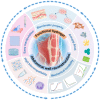
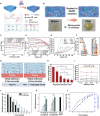
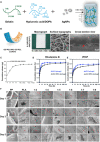
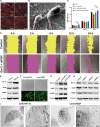
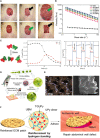

Similar articles
-
Functional hydrogels for the repair and regeneration of tissue defects.Front Bioeng Biotechnol. 2023 May 16;11:1190171. doi: 10.3389/fbioe.2023.1190171. eCollection 2023. Front Bioeng Biotechnol. 2023. PMID: 37260829 Free PMC article. Review.
-
Advances in bioactive glass-containing injectable hydrogel biomaterials for tissue regeneration.Acta Biomater. 2021 Dec;136:1-36. doi: 10.1016/j.actbio.2021.09.034. Epub 2021 Sep 23. Acta Biomater. 2021. PMID: 34562661 Review.
-
Hydrogel derived from porcine decellularized nerve tissue as a promising biomaterial for repairing peripheral nerve defects.Acta Biomater. 2018 Jun;73:326-338. doi: 10.1016/j.actbio.2018.04.001. Epub 2018 Apr 9. Acta Biomater. 2018. PMID: 29649641
-
Bioactive hydrogels for bone regeneration.Bioact Mater. 2018 May 26;3(4):401-417. doi: 10.1016/j.bioactmat.2018.05.006. eCollection 2018 Dec. Bioact Mater. 2018. PMID: 30003179 Free PMC article. Review.
-
Designing a bi-layer multifunctional hydrogel patch based on polyvinyl alcohol, quaternized chitosan and gallic acid for abdominal wall defect repair.Int J Biol Macromol. 2024 Apr;263(Pt 1):130291. doi: 10.1016/j.ijbiomac.2024.130291. Epub 2024 Feb 18. Int J Biol Macromol. 2024. PMID: 38378119
Cited by
-
Polymer Brush-Based Asymmetric Porous Patch with Excellent Anti-Bacterial and Anti-Contamination Properties Enables Infectious Abdominal Wall Defect Repair.Adv Sci (Weinh). 2025 Jul;12(25):e2500865. doi: 10.1002/advs.202500865. Epub 2025 Apr 7. Adv Sci (Weinh). 2025. PMID: 40192184 Free PMC article.
References
-
- Rathore A, Murherjee I, Kumar P. Traumatic abdominal wall injuries: A review. Minerva Chir. 2013;68(3):221–232. - PubMed
-
- Gillion J, Sanders D, Miserez M, Muysoms F. The economic burden of incisional ventral hernia repair: A multicentric cost analysis. Hernia. 2016;20(6):819–830. - PubMed
-
- Beadles CA, Meagher AD, Charles AG. Trends in emergent hernia repair in the United States. JAMA Surg. 2015;150(3):194–200. - PubMed
LinkOut - more resources
Full Text Sources

